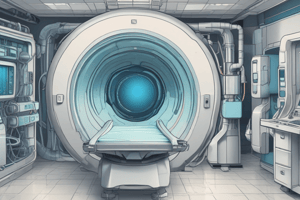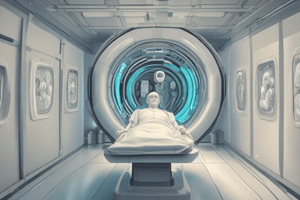Podcast
Questions and Answers
What is the primary purpose of Maximum Intensity Projection (MIP) in CT imaging?
What is the primary purpose of Maximum Intensity Projection (MIP) in CT imaging?
- To average pixel values for better image quality
- To display the lowest value pixels along a line
- To create a full 3D image using all data points
- To reconstruct images using the highest value pixels along any line (correct)
Which view does the Multiplanar Reconstruction (MPR) NOT allow?
Which view does the Multiplanar Reconstruction (MPR) NOT allow?
- Saggital
- Rectangular (correct)
- Coronal
- Transverse
How does the Shaded Volume Display (SVD) enhance image quality compared to Shaded Surface Display (SSD)?
How does the Shaded Volume Display (SVD) enhance image quality compared to Shaded Surface Display (SSD)?
- By focusing on surface boundaries only
- By limiting the viewing angle
- By utilizing the entire data set (correct)
- By using only selected pixels
What is one limitation of using Maximum Intensity Projection (MIP)?
What is one limitation of using Maximum Intensity Projection (MIP)?
Which of the following is NOT a type of image representation mentioned in the content?
Which of the following is NOT a type of image representation mentioned in the content?
What distinguishes the Shaded Surface Display (SSD) from other imaging techniques?
What distinguishes the Shaded Surface Display (SSD) from other imaging techniques?
In what way does Multislice helical CT excel?
In what way does Multislice helical CT excel?
What is the main advantage of the Shaded Volume Display (SVD) compared to other imaging methods?
What is the main advantage of the Shaded Volume Display (SVD) compared to other imaging methods?
Which method measures the scanner's ability to separate two adjacent objects?
Which method measures the scanner's ability to separate two adjacent objects?
What does a low spatial frequency represent in CT imaging?
What does a low spatial frequency represent in CT imaging?
How does slice thickness affect spatial resolution in CT imaging?
How does slice thickness affect spatial resolution in CT imaging?
What reflects the ability to distinguish soft tissues in CT imaging?
What reflects the ability to distinguish soft tissues in CT imaging?
What is the primary cause of image noise in CT systems?
What is the primary cause of image noise in CT systems?
Linearity in CT imaging refers to which of the following?
Linearity in CT imaging refers to which of the following?
What type of object tends to drift in CT imaging measurements?
What type of object tends to drift in CT imaging measurements?
Which technique is used to increase image accuracy by manipulation of raw data?
Which technique is used to increase image accuracy by manipulation of raw data?
What effect does high noise have on CT images?
What effect does high noise have on CT images?
What is the primary benefit of solid-state detectors compared to film in CT imaging?
What is the primary benefit of solid-state detectors compared to film in CT imaging?
What does a high noise level in CT images typically indicate?
What does a high noise level in CT images typically indicate?
What effect does image filtering have on CT images?
What effect does image filtering have on CT images?
Which parameter directly affects the uniformity of CT images?
Which parameter directly affects the uniformity of CT images?
Flashcards
MPR (Multiplanar Reconstruction)
MPR (Multiplanar Reconstruction)
A computer program that transforms images from axial/transverse views into coronal, sagittal, and oblique views.
Coronal View
Coronal View
A view of a body part from front to back.
Sagittal View
Sagittal View
A view of a body part from left to right.
MIP (Maximum Intensity Projection)
MIP (Maximum Intensity Projection)
Signup and view all the flashcards
Shaded Surface Display (SSD)
Shaded Surface Display (SSD)
Signup and view all the flashcards
Shaded Volume Display (SVD)
Shaded Volume Display (SVD)
Signup and view all the flashcards
Multislice Helical CT
Multislice Helical CT
Signup and view all the flashcards
Partial Volume Averaging
Partial Volume Averaging
Signup and view all the flashcards
Spatial Resolution
Spatial Resolution
Signup and view all the flashcards
Spatial Resolution Factors
Spatial Resolution Factors
Signup and view all the flashcards
Contrast Resolution
Contrast Resolution
Signup and view all the flashcards
Contrast Resolution and HU
Contrast Resolution and HU
Signup and view all the flashcards
Noise in CT
Noise in CT
Signup and view all the flashcards
Noise Factors
Noise Factors
Signup and view all the flashcards
Linearity in CT
Linearity in CT
Signup and view all the flashcards
Uniformity in CT
Uniformity in CT
Signup and view all the flashcards
Localizer Scan (Scout)
Localizer Scan (Scout)
Signup and view all the flashcards
Image Filtering
Image Filtering
Signup and view all the flashcards
Window Width (WW)
Window Width (WW)
Signup and view all the flashcards
Window Level (WL)
Window Level (WL)
Signup and view all the flashcards
Image Reconstruction
Image Reconstruction
Signup and view all the flashcards
Line Pairs per cm (lp/cm)
Line Pairs per cm (lp/cm)
Signup and view all the flashcards
Attenuation Coefficient
Attenuation Coefficient
Signup and view all the flashcards
Study Notes
CT Image Quality
- Five methods are used to measure CT image quality: spatial resolution, contrast resolution, noise, linearity, and uniformity.
Spatial Resolution
- Spatial resolution measures how well a CT image can differentiate small objects.
- Blurring of sharp interfaces in images is inversely proportionate to spatial resolution.
- Smaller pixel sizes result in better spatial resolution.
- Spatial resolution depends on pixel size.
- Low spatial frequencies represent large objects, while high frequencies represent small objects.
- Resolution is related to the detector element size; thinner slices and smaller voxel sizes improve resolution.
- Spatial resolution is expressed as line pairs per centimeter (lp/cm).
Contrast Resolution
- Contrast resolution refers to the ability to differentiate tissues with similar densities.
- Multislice helical CT excels in this area.
- The attenuation coefficient depends on x-ray energy and the atomic number of the tissue.
- CT utilizes x-ray absorption to determine tissue density.
- Amplified contrast scales improve differentiation of adjacent tissues.
- Contrast resolution is affected by image noise and the uniformity of the object.
Noise
- CT image noise appears as graininess.
- Noise is affected by various factors such as kVp, filtration, pixel size, slice thickness, detector efficiency, and patient radiation dose.
- Low noise appears smooth, while high noise appears spotty or blotchy.
- Variation in CT numbers from the ideal zero value is a measure of noise.
- Image noise limits the resolution of low-contrast objects.
Linearity
- Linearity refers to the relationship between CT numbers and the linear attenuation of the imaged object.
Uniformity
- Uniformity ensures consistent CT number values for a uniform material (e.g., water).
- CT values for water can vary slightly from day to day or hour to hour.
CT Image Manipulation and Display
- Localizer scans (scout images) are used to position the patient and verify anatomy in the CT scan field of view.
- These scans are performed with the x-ray tube stationary.
- Image enlargement reduces resolution.
- Image filtering techniques smooth the image and, in some cases, enhance edges.
- Contrast is improved by adjusting window width and level.
Image Manipulation
- Image reconstruction is the process of manipulating raw CT data
- various image manipulations and filters produce modified images (e.g., MIP, MPR)
- Various manipulation techniques include different filters, display field of view, multiplanar reconstructions, and maximum intensity projection.
3D Imaging
- Multiplanar reconstruction (MPR) is a method to generate sagittal, coronal, and oblique views from axial images.
- Other 3D image manipulations allow for volume and surface rendering, maximizing intensity projections, and shaded surface/volume displays.
Studying That Suits You
Use AI to generate personalized quizzes and flashcards to suit your learning preferences.




